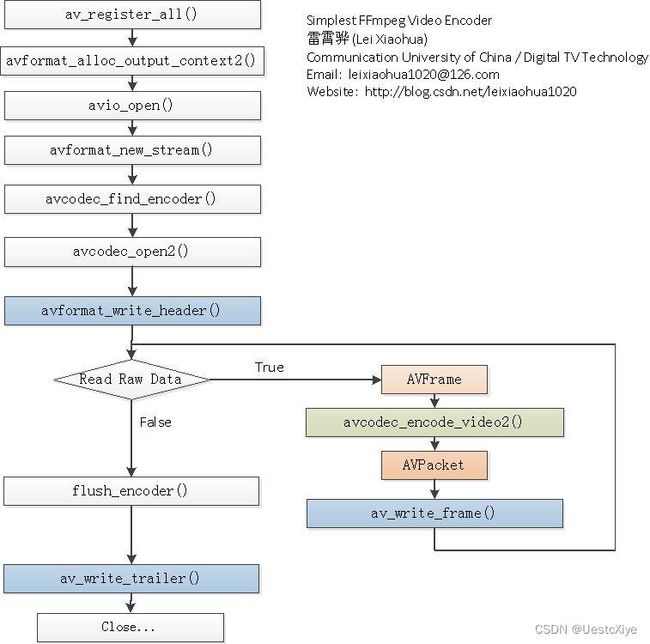最简单的基于 FFmpeg 的视频编码器(YUV 编码为 H.264)
最简单的基于 FFmpeg 的视频编码器(YUV 编码为 H.264)
- 最简单的基于 FFmpeg 的视频编码器(YUV 编码为 H.264)
-
- 正文
- 结果
- 工程文件下载
最简单的基于 FFmpeg 的视频编码器(YUV 编码为 H.264)
参考雷霄骅博士的文章,链接:最简单的基于FFMPEG的视频编码器(YUV编码为H.264)
正文
本文介绍一个最简单的基于 FFmpeg 的视频编码器。
该编码器实现了 YUV420P 的像素数据编码为 H.264 的压缩编码数据。
下面附一张使用 FFmpeg 编码视频的流程图。使用该流程,不仅可以编码 H.264 的视频,而且可以编码 MPEG4/MPEG2/VP8 等等各种 FFmpeg 支持的视频。图中蓝色背景的函数是实际输出数据的函数。浅绿色的函数是视频编码的函数。
简单介绍一下流程中各个函数的意义:
- av_register_all():注册 FFmpeg 所有编解码器。
- avformat_alloc_output_context2():初始化输出码流的 AVFormatContext。
- avio_open():打开输出文件。
- av_new_stream():创建输出码流的 AVStream。
- avcodec_find_encoder():查找编码器。
- avcodec_open2():打开编码器。
- avformat_write_header():写文件头(对于某些没有文件头的封装格式,不需要此函数。比如说 MPEG2TS)。
- avcodec_encode_video2():编码一帧视频。即将 AVFrame(存储 YUV 像素数据)编码为 AVPacket(存储 H.264 等格式的码流数据)。
- av_write_frame():将编码后的视频码流写入文件。
- flush_encoder():输入的像素数据读取完成后调用此函数。用于输出编码器中剩余的 AVPacket。
- av_write_trailer():写文件尾(对于某些没有文件头的封装格式,不需要此函数。比如说 MPEG2TS)。
源代码:
// Simplest FFmpeg Video Encoder H.264.cpp : 定义控制台应用程序的入口点。
//
#include "stdafx.h"
#include 结果
运行程序,将输入 YUV 文件编码为 H.264 文件,以下是其信息:
可以正常播放。
工程文件下载
GitHub:UestcXiye / Simplest-FFmpeg-Video-Encoder-H.264
CSDN:Simplest FFmpeg Video Encoder H.264.zip


